"Gen Z" Protests Regain Peacefulness After Days of Tension
Morocco’s youth-led protests have spread to several cities, and on the sixth day they regained their peaceful character, with participants once again calling for better essential services in the health sector.

After a tense night on Wednesday, October 1st, marked by incidents of violence in some areas, the “Gen Z 212”
protests returned to a calm and peaceful tone yesterday, Thursday, October 2nd. Youth gatherings took place in several
Moroccan cities, where chants demanding social justice and reforms in education and health resonated.
In Casablanca’s Place Maréchal, hundreds of young men and women gathered, reaffirming the peaceful nature of their movement.
Meanwhile, dozens more rallied in Rabat’s Agdal neighborhood, voicing slogans critical of the government.
The demonstrations also reached other cities including Mohammedia, Tetouan, Agadir, and Tangier, where participants denounced
the decline of basic healthcare services.
Women at the Heart of Protest
The demonstrations featured a notable presence of women, as young women raised slogans demanding the right to health,
education, and job opportunities. This movement, led by a digitally connected generation, underscores how women’s voices
have become integral to the broader protest landscape.
By maintaining peaceful gatherings, the movement—launched last Saturday, September 27th—shows that the Moroccan street
remains alive and determined, even after earlier clashes that claimed three lives. While the government is accused of being
unable to carry out real reforms, young people continue to call on the King to directly intervene in addressing the country’s
social challenges.
Years of Protest
This youth movement comes within a longer tradition of protest in Morocco. During the Arab Spring of 2011, Morocco experienced
waves of demonstrations that remained firmly peaceful, avoiding the violence and extremism seen in other countries.
In recent years, the country has also witnessed localized social movements over education, healthcare, and poverty. Yet none
managed to unite the major cities to this extent. By contrast, the “Gen Z” movement stands out as a digital, youth-driven
uprising that connects young people across regions quickly and holds on to peaceful tactics, even after initial confrontations
with security forces.
Authorities now face a double challenge: responding to long-accumulated social demands, while managing a digitally fueled
and non-partisan youth movement—one that is difficult to predict or control. Analysts suggest that the return to peaceful
protest on Thursday offers a window for calm and dialogue. It also reflects young people’s awareness that violence would
undermine both their credibility and the public and international sympathy they have gained.
Scenarios Ahead
As the protests enter their sixth day, the future of “Gen Z” remains uncertain. The movement could succeed in imposing
its social agenda through organized peaceful pressure, or it might recede under the weight of arrests and state pressure.
What is certain, however, is that this generation—born into the digital age—has already succeeded in making its voice part
of the national debate. It has shown that youth and women are indispensable to any future reform in Morocco.
So far, the government’s stance has been cautious yet positive. Morocco’s official spokesperson stressed openness to dialogue
with the youth and pledged to review government priorities. He acknowledged the shortcomings of the healthcare system and
promised improvements, alongside constructive talks with the young protesters.
